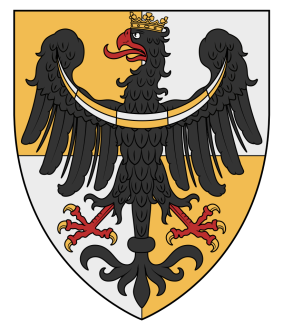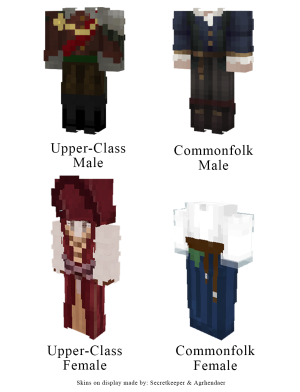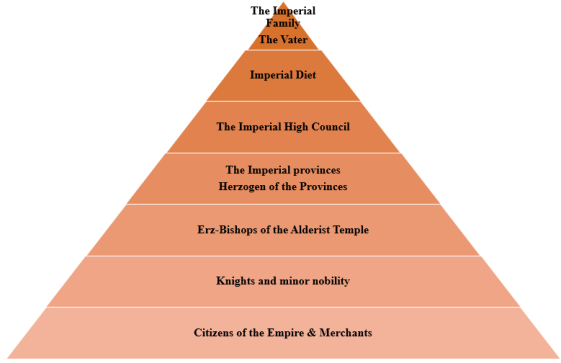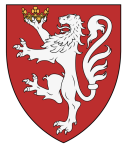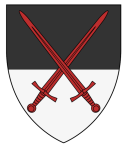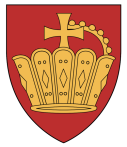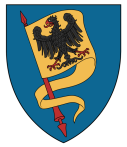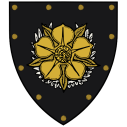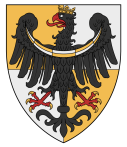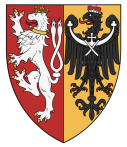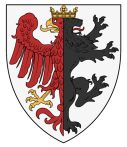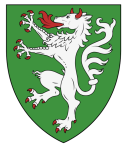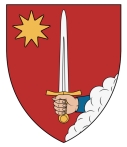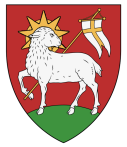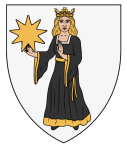The Hadrian Empire
| Capital | Adelsburg |
| Location | The Heartlands, The Hinterlands, |
| Races | Attian Humans |
| Primary Religions | Alderism |
| Political System | Monarchy |
| Current Leader | Kaiser | Diederick-Gobel von Lichtenfelts
Kaiserin | |
| The Imperial Council | ErzCupbearer |
ErzSteward | Reichsmarshall | ErzTreasurer | ErzBannerbearer | |
| Preceded by: | |
Introduction
The Hadrian Empire, often referred to as simply ‘the Empire’, is the far-stretching country west of Eden’s Spine. A land inhabited mainly by the dutiful folk that are the Attian humans, one can see the many fields that cover the landscape being toiled by its hard-working citizens. Its cities are often bustling with life, places where trade, commerce and politics take the main stage. The Hadrian way of life is deeply rooted in tradition and is often relatively simple, mainly because of this the Hadrians are known for their versatility and perseverance through hardship. The civil wars that have plagued the country in the past have left their scars, yet it seems Hadrians always find their way back, dedicating such feats to their deity; Alder. Within the Empire, the political and the martial often go hand in hand, with a large focus on retaining order and stability through military force. Within the Empire, it is not uncommon to see commoners rise through the ranks, oftentimes talented men and women are recognised and get the chance to prove themselves useful to their nation in places such as the army and its Duma. A land full of chance, and one of recognition, with its Kaiser at the helm.
Culture and Society
Apparel
Upper-class citizens & nobles.
Citizens of the Hadrian empire are an incredibly diverse people which also translates to their apparel. Those living in the capital prefer a more aristocratic outlook. The men of higher standing dress in formal robes and suits decorated with imperial medals they earned throughout their careers. Often this goes paired with leather boots created by the finest shoemakers in Adelsburg, or imported from Anjyarr. However, this is a phenomenon mostly seen among trader families due to their access to merchant ships that cross the Al'Hadar Deep. Those from military families often wear decorative bits and pieces of armor over their outfits to represent their family careers. The cloaks, suits, and robes of upper-class citizens come in a plethora of colors, though most choose to represent their house by wearing house colors primarily in some way. To top it all off, upper-class men like to wear impressive headdresses decorated with large dyed peacock feathers.
The women of the capital region, The Grand Principality of Brandenhafen, follow the trends set by currently popular designers that work for the tailor’s guild in Adelsburg. They do not necessarily follow the “house color” standard set by the men and are often much more colorful, combining local, house, and exotic colors only made possible by the import of dyes and silks from the south. These marvelous dresses go paired with the trend of long and flowing hair and golden jewelry often in the shape of Nine-pointed-star necklaces and rings decorated with popular gems such as Citrine, Amethyst, and Ruby.
Those of higher standing from the provinces are a lot less colorful, often sticking to the house color standard or in the case of richer families, import expensive coats and dresses from the capital region or in the case of merchant families, from the southern regions that create many of the expensive fabrics used in the clothing of rich imperials.
Commonfolks
The average imperial citizen is far from as colorful as the upper class. Usually resorting to brown, red, and green-tinted fabrics as those are the easiest to obtain in Imperial lands. In many cases, citizens of the empire wear their available clothes in all kinds of interesting and in some cases comical combinations, for example, wearing a soldier’s shirt and trousers obtained during service in the imperial army combined with a large leather coat and a simple hat decorated with a feather found fallen off a noble’s hat. Imperial citizens are extremely resourceful people and despite their lack of access to expensive and colorful fabrics do their very best to look as good as they can, often trying to imitate the looks of nobles with what little resources they have. This is all to increase their chances in the tight job market in the Imperial Capital region. Those who are or have been in the army often use parts of their uniform to increase the appeal of their outfits and make sure people see them as veterans. Commoners too are fond of impressive headdresses, though men are seen wearing them more often than women. They’re usually modified soldier’s or sailer’s hats decorated with pins and feathers they find.
Outliers
As stated, the Hadrian Empire is an incredibly diverse people with their own cultures and customs. People from all over the continent travel to the imperial provinces to make it their home and taste a piece of the riches it has to offer. Though these migrants are not always welcomed with open arms. They stand out like no other in the Imperial Lands as they care not for imperial fashion or beauty standards. Examples of these people would be the Halflings or Denur, who mainly settled in the Bergwald province. Halflings tend to wear farmer’s rugs and suits made by local halfling tailors, mostly being a colorful patchwork of different styles and costumes. Naturally, this is the result of Halflings being unable to actually fit human-made clothes, and many imperial tailors being unwilling to provide for the small Halfling minority. The Denur on the other hand, stubborn as they are, only wear clothes imported from the Denur holds of the north and east, despite them being imperial citizens they look like and are often mistaken for travelers from the Denur holds. The Denur are a proud race and citizenship in the empire doesn’t mean they have forgotten their heritage and culture. Because of this little demand for imperial outfits for the Denur the Halfling’s problem with low demand for small sizes only accelerated, encouraging the development of their own fashion.
Another noteworthy outlier is the Imperial Tiefling. They do not mind the imperial clothes and fit them just fine, though the Tiefling populous tend to cast any sort of logic for imperials when creating an outfit aside, instead of following the house color standards and latest fashion trends, the Tieflings tend to wear their combinations based on how they are feeling at the time or what they are trying to represent, similar to the skin painting custom they inherited from their ancestral home of Nous.
Social Hierarchy
The Hadrian Empire as being the most populous human nation on the continent of Eden has developed a complex social hierarchy kept together with an overwhelming bureaucratic system to keep the wheels turning. From the imperial lawmakers to the simple workers on the field receiving their tax slips once again, everyone feels the cranking gears of the imperial social machine. This monstrous construction is the result of the lawmakers of the Imperial Capital, Adelsburg, constantly simply writing new laws and decrees on top of the existing system, ever-expanding the size of the state and its complexity. Any attempt to unwind this system and rework it from the ground up is often met with sabotage from the established order, not in an attempt to sabotage the state itself, naturally, but to preserve the personal power and influence this web of laws and decrees have built for those saboteurs and their families. Though through all this complexity and constantly expanding states there is a simple way to explain this imperial machine and its inner workings and hierarchy.
The Imperial Family
The Hadrian Empire’s Imperial family consists of those chosen by the Imperial Diet to rule the Empire. Only Herzogen of the recognized duchies of Hertzland, Veronia, Bergwalts, and Hölzland together with the family ruling over the crownlands, the principality of Brandenhafen, can be chosen for the role of the emperor after the sitting one dies or decides to abdicate. There is no such thing as a set imperial dynasty and every Herzog can one day grow to become the Emperor and move with their household to the capital of Adelsburg. The Emperor, or Kaiser in the Attian dialect, and his family hold immense power over the imperial diet and lawmakers of the Empire for it is the Emperor alone who can assign lawmakers to the High Imperial Council. Within the diet itself, the Kaiser holds a ceremonious three votes, yet the emperor can choose to veto any decision within this parliament. Today, the Empire is ruled by Kaiser Diederick-Gobel von Lichtenfelts who reigns from his court in Adelsburg.
The Vater
The head of the Alderist Temple is known as the Vater, translating to the Father of the Alderists. He is the sole chosen leader of the faith within the Empire and therefore holds immense power within the Empire despite not being as involved in Imperial politics outside the diet, where he holds three votes in the name of the temple. Yet one could easily argue that the political power of the Vater is much greater than the three votes he has to his name as he can choose and place two other Erzbishops in the Grand Duchies of the Empire, that being Hertzland and Veronia. These Erzbishops too hold a singular vote in the Diet, bringing the total power of the Temple to five votes. This power was obtained through the position the temple managed to place itself in throughout the years, for they are the sole representatives of the founder of the Empire, Alder himself, and by acting as a bastion of faith and hope for the Imperial citizens have they slowly but surely grown to a massive institution that can be found in many forms throughout the Empire. Be it in the temples as preachers, be it as a cultist of Mortius at a local funeral, or as battle wizards on the battlefield. The temple’s servants are everywhere and the Vater is the undisputed leader of it all.
The Imperial Diet
The primary decision-making body of the Empire is the Imperial Diet, it is a council of all the Herzogen of the imperial provinces and heads of faith. Each representative within the Diet holds a certain number of votes which they can use to shape the future of the Empire. The diet itself is completely inaccessible for regular citizens and lower nobility, only the electors and their servants are allowed within the halls of the diet in Adelsburg. It is here where laws are proposed and accepted before being sent to the imperial councils throughout the empire. There are only two pathways for any individual toward getting a seat within the diet, those are climbing the hierarchical ladder of the Temple of Alder, becoming either an Erzbishop or the Vater, or climbing the political ladder, becoming the head of a great house that rules over an imperial Duchy or the grand principality of Brandenhafen.
The High Imperial Council
This council is the product of emperor Diederick-Gobel von Lichtenfelts and consists of five high council seats. Each of these positions acts as an extension of the emperor and often takes action in his name. To become a council member, one has to be noticed by the ruling emperor for it is only he who may choose the council members for the duration of his reign. People from all walks of life could on paper become part of this council, yet it is extremely rare to see someone from outside the emperor’s inner circle on one of these seats. Imperial council members are held in high regard but have in actuality very limited political power outside their designated roles. They do not hold voting rights in the Diet and can be dismissed without pardon by the emperor.
The five imperial council seats:
The Imperial Provinces
When leaving the imperial capital, Adelsburg, and its direct surroundings, one crossing through the empire will soon find themselves in one of the imperial provinces. These semi-independent city-states held much of the local power, only answering the Hadrian Imperial Court, The Diet, and the Emperor to whom they swore allegiance. The provinces of the empire do not have a standardized way of government, often that is decided by the ruling Herzog or Herzogin and their council. The provinces hold the right to create their own local laws and punish criminals according to them, only being able to be overruled by the Imperial Court or an edict from the emperor himself.
The style of government varies a lot between provinces, while the grand principality of Brandenhafen, due to it being the Imperial seats are firmly autocratic, the now diminished Hinterlander provinces of the east traditionally held more democratic views, even declaring themselves a republic instead of a kingdom during the second Hadrian Civil war when the nation broke apart. Due to these vastly different styles of local governments, the lives of citizens can be greatly affected by who sits on the Herzog’s seat at the time. Though despite that, citizens tend to remain in their ancestral homeland, even if the conditions are far better in the neighboring provinces. This mostly is the result of a stubborn form of pride and patriotism for the imperial province the citizens reside in.
The initial borders of the imperial provinces were originally determined back in the day of the first Hadrian kings after the Attian Migration south. They were drafted along natural features and ethnic lines between Hinterlander natives and Attian settlers. Though throughout the centuries, internal squabbles, wars, coups, and destruction of entire dynasties since the days of the plague have drastically changed the original layout of the imperial provinces to what the people are more familiar with in this day and age. A great number of ancient bloodlines and their states have either been altered in shape and size or are outright forgotten and disappeared from history.
Being a Herzog of an imperial province is a very prestigious position as they are all technically next in line to become the Emperor. Once the sitting emperor either abdicates or dies, the Herzogen of all the states are called to the capital to vote amongst themselves for a new emperor.
Erz-Bishops of the Alderist Temple
Within the imperial provinces exist many extensions of the Alderist temple whose primary seat of power is in the capital of Adelsburg. Among the highest of these pious men and women are the Erz-Bishops, these wearing the cloaks of the Erzbishop are local religious leaders appointed by the Vater himself. The Bishops hold little in terms of political power outside a vote in the Diet, yet they are considered the pillars of the provinces by local citizens and are responsible for upholding Alder’s order and uprooting any form of heresy when it is found by any means. They have strong ties with the local cults of Mortius, working together with them to safeguard the plains of Mortius and using the martial prowess of Mortius’ followers to brutally assault voidal cultist’s headquarters and execute religious troublemakers.
Knights and Minor Nobility
Serving the Herzogen of the imperial provinces are various minor nobles and knightly orders. These are in most cases a circle of upper-class citizens and landowners who hold various local titles. The local knightly orders often act as the core of the provincial military forces, mostly swearing allegiance to their local Herzog and only following his commands. These peoples hold little national power, yet through their martial prestige and influence on a local level, lots of citizens aspire to one day grow to one of these positions as a first step towards Herzogdom.
Noteworthy Knightly Orders:
Citizens of the Empire & Merchants
At the very bottom of the social ladder dwell the hordes of ordinary citizens that fill the cities and towns of the Empire. Craftsmen, Fishers, Farmers, Merchants, and blacksmiths all belong to this caste of commoners. They fill the ordinary roles within the Empire. The citizenry is the most numerous caste and forms the backbone on which the great imperial machine stands. In times of war or voidal incursions, many ordinary citizens are called up for military service to protect their homeland. Most citizens live a poor man’s life and have to provide for themselves on a day-to-day basis as there is no imperial system to protect them from the poor conditions they often find themselves in.
Political Beliefs
History and Overview
Against the general expectations of many, the Hadrian Empire is not a unified nation ruled by a powerful central government, but it is actually a big confederation of city-states and knightly holdings. The most prominent of these, the Grand Duchies and the Principality of Brandenhafen make up the closest thing to an Imperial central government called the Imperial Diet through their rulers. The Members of the Duma are a collection of prominent Imperial Nobles and clergymen who together vote on the direction of the empire and a new emperor if he happens to die or abdicate. The Imperial Provinces are tied together in this confederation through a common faith, culture, and belief that they will be overrun by the powers of the voidal plane on their own. During the days of the early Hadrian Empire, Kaiser Philipp II von Lichtenfelts reformed the political system of the empire towards a more centralized government and introduced the Hadrian Duma which was essentially a citizen ran governmental body that had authority over the entire Empire, to the great dislike of the Herzogen who were fiercely in favour of more regional autonomy. Especially the noble house of Tzyrnowski from the northern province of Flüssland was fiercely critical of the Duma. This eventually led to a short-lived coup attempt from Herzog Janczyck Marius Tzyrnowski in an attempt to take over and steer the empire in a different direction. The coup failed and the Duma lived on for a few more years.
The Hadrian Duma was eventually replaced with an imperial council introduced by a successful usurper by the name of Sine Verrador. After Sine overthrew the Kaiser during the Hadrian-Raevendrecht War of 1530, he vowed to reform the empire and its political system to fight the tyranny the empire was under during the rule of the Kaisers. Though ambitious, the new Imperium was relatively successful for a few months until rumors were heard of the brother of Kaiser Philipp, Diederick, was forming an army in the break-away province of Flüssland to retake the empire from the usurpers. Diederick’s campaign was successful and the usurpers were driven out. After the empire was restored under the Lichtenfelts dynasty, Diederick restored the original Imperial Diet system from the early days of the empire.
The Imperial Diet
The Imperial Diet consists of a total of nine seats with each a set number of votes to their name. The diet acts more or less as an imperial forum where nobles and clergymen from all over the empire come together to negotiate and compromise on imperial law, the division of imperial lands, and choosing the next emperor in the scenario of the sitting one dying. The Imperial Diet’s votes are split among the high nobility and clergymen. Where grand duchies and principalities enjoy the privilege of having multiple votes due to their size, influence, and population, the smaller duchies only have a singular vote. The Alderist temple and her branches have a total of five votes split among them. The right to vote essentially rests on territorial entitlement and clerical power. When a new Herzog, Erzbishop, or Vater is chosen, they automatically inherit the voting rights of their predecessor.
| The Imperial Family
3 votes |
Herzog of Brandenhafen
2 votes |
Herzog of Hertzland
2 votes |
Herzog of Veronia
2 votes |
Herzog of Bergwaltz
1 vote |
Herzog of Hölzland
1 vote |
Vater of the Alderist Temple
3 votes |
Erzbishop of Veronia
1 vote |
Erzbishop of Norbüren
1 vote |
Commerce and Work
Due to the dedication the people of Hadriana put into their work, providing for themselves and the nation, Hadriana became known as a nation of mass-producing quality products. From your furniture, tools from the blacksmith, to the best quality bred horses of Eden. The many different kinds of career options in Hadriana give its citizens and newcomers plenty of opportunities to learn new skills to share with the nation.
Hadriana provides its nation with different kinds of Mead and Ale. But are also the founders of the Golden Stallion Whiskey, but also Vodka and Rum liqueur. Quantities equal to the different kinds of Elven wine. But even the army provides for anyone who wishes to learn the ways of the sword.
To those who wish to unite themselves in groups of same interest craftsmen and trades are gathered in different guilds. When cooperating, certain tradesmen can apply to raise a guild. In return for the privilege of a guildhouse the guid pays a monthly fee. Some guilds may differ in structure but an overlapping theme with guilds is that the guild appoints a master of a certain trait. This master is allowed to keep several apprentices for a certain period of time. These apprentices will rise through the ranks of the guilds to earn their privileges to set up a prominent shop.
Celebrations and Holidays
- Day of the Squire
The Day of the Squire serves as a way for any willing Attian to prove themselves worthy of being Squire to a Knight by going through a series of tests and challenges. Local farmhands, workers, serfs, and all other citizens can participate freely in the trials. A chosen jury of Knights will accompany the Kaiser and will judge the trials, deciding who may proceed through the rounds. The winner of the Day of the Squire is granted a hand-written recommendation from the Kaiser himself to bring to a Knight of their choice, in an attempt to serve them as their Squire. The Kaiser also grants them a so-called ‘Golden Griffin’, which is a coin that serves as memorabilia and as proof of authenticity. Each rendition of the event offers its own new set of challenges and trials, ranging from jousts to melees or battles of wit, as all aspects that make a Knight must be put to the test.
- The Gryphite Victory Tourney
Once every four years, a tournament is held at the Imperial capital, Adelsburg. At this renowned tourney, people from all over the continent are invited to witness the various knights and soldiers of the Hadrian realm compete for honour and glory in their most prestigious armours decorated with colourful clothes and large plumes. The tourney’s content is vaguely based on the events of the heroic victory achieved at the battle of the Heartland pass. Here knights of the Order of the Griffin hold a parade through the streets of the capital followed by their personal retinues, bearing the banners of their houses. After this show, all attendants gather at the tourney ground where they will simulate great duels from the battle. These go paired with jousts, archery contests and single combat duels between the lower Knights. The tourney is intensely followed by people all around the world, and bards usually take much inspiration from its happenings for their songs and tales.*Festival of the Ashes Originating from the day the Attians founded the first Kingdom of Hadriana after the great collapse of the Attian Empire, followed by the journey south led by Kaiser Onnodrith. On this day, the Empire celebrates by dressing up in the old garments and cultural styles of their ancestors. The Attians do this as a way to remember the olden days before the downfall. Here they play songs, dance, and feast in the capital for the entire day. Certain people who are often referred to as street actors and jesters, wear monstrous masks to play the role of terrors and demonic beings. These actors try to emulate the happenings of that fated day, as the festival doubles as a day of remembrance as well as celebration
- Krügerfest
It is a tradition within Attian societies to celebrate when the first leaves drop from the trees, which they call Krügerfest. During the day and the following night, all public drinking laws in Attian settlements are lifted, and people celebrate in unison all through the streets. It is customary that drinking competitions are held, eventually crowning someone ‘King Krüger’ for the night. The holiday originates from the tale that a man bearing the name Krüger visited a northern village on the first day of the Amber Dawn, dragging a cart filled with ale, mead and whiskey. The villagers drank deep into the night as the celebrations carried on, this northern tale has now been accepted as fact by most of the Attian population and is celebrated every year.
- Geistertag
Geistertag, commonly known as the ‘Day of the Dead’, is a special day on every Attian’s calendar, for it is the day the Eseron and Lilith cross one another. There have even been sightings of Lilith itself, clear in the night sky on this day. Lilith’s influence over the mortal realm is believed to be at its highest point, which has many unforeseen consequences. Attians believe that if you were to step outside during this day, deceased relatives would come back from the dead to get a hold of their potential host. Every year, unforeseen disappearances are reported to happen commonly on this night in particular, fueling the legend of this day. A common countermeasure against these spirits used by the Attian populace is to surround one’s house with carved pumpkins and keep all doors and windows tightly shut. If one were to possess any portraits or paintings which depict a deceased relative, all of them must be turned around so that they cannot be seen, seeing as they are witnessed as portals the entities from Lilith use. After the conclusion of this night, all of the Attians come together in their respective communities for a shared breakfast, along with a ritual pumpkin burning to rid the last of the spirits, sending them back to the realm of the dead.
- Hexensnacht
The Hexensnacht is the celebration of the commencement of the new year in Eden, this night is usually filled with drinking and eating the signature dish of the evening: the Oliebal, a ball of fried dough with raisins imported from Anjyarr. For the occasion, special balls of coloured powder are produced that can be mounted on arrows. Attians shoot these balls into the night sky, watching them explode into a colourful explosion which lights up the grim winter night. These celebrations go all through the night, as the Attians believe anyone that sleeps shall be tortured by terrible nightmares depicting their own demise, or that of their loved ones.
Religious Beliefs
The primary religion within the Kingdom of Hadriana is known as Alderism. The followers of the one and only God, The Maker, believe that he is the one who created the heavens, soil and life of Eden. Together with the nine Sentinels, each one represents emotions and challenges that all humans will encounter throughout their lives.
The clergy may outwardly appear as a humble social class wielding little power beyond ceremony, the truth of the clergy is much deeper. As the appointed representatives and servants of the Maker and the Sentinels, the word of the clergy is treated practically as law in the deeply religious society of Hadriana. They are pervasive throughout Hadric society. In every village there is a chapel to the Maker or a shrine of a sentinel, and in every noble court there is a resident clergyman. When a child is born, they are taken to the clergy. When a couple is to be wed, it is a clergyman who officiates. Even in death the clergy’s influence is felt, as clergymen are there to administer religious rites at any funeral.
The people of Hadriana believe in an afterlife. Those who live by the principle guidelines of the Maker’s traits, known as the Nine Wisdoms, are welcome to join him there in the realm of Heavens. This place is where one is presented by all his or her life choices and can reflect on the time that was given to them on Eden. Eventually living out the rest of their lives in these realms in peace.
However, if one does not live by the Maker’s teachings, one will fall into the abyss of the mirror realm, to a place the light can’t reach.
This mirror realm has many names in Hadrian religion. It is both known as The Void or The Four Hells. This realm is ruled by Dolus, the sentinel of corruption and deceit. He punishes those who fell to his corruption by turning them into monsters he unleashes onto Eden. Hence, being “corrupted” or known as turning Heretic is punished severely.
On the Nine Wisdoms.
“As the night crept over the fields, Onnodrith looked up to the skies and saw the bright star of Hadrius. At this point, the star became so overpowered with light that through it the sentinels all came forth. Above them, hovered a man covered in bright light. The Maker presented himself to Onnodrith and his children. And together each of the children, good and bad, presented the nine rules the Attians had to follow. Nine rules that were needed for the Attian race in their new home. The sentinels sang and danced one last time together before Onnodrith, encouraging him to ride back to his home and settle the new kingdom. And only with a new start could its people survive, guided by the Nine Wisdoms of the Maker.”
- You will not have faith in false gods.
- You will not take the word of the Maker in vain.
- You will take the first day of the nine day week for holy contemplation.
- You will respect your forefathers.
- You will not take life.
- You will stay true in marriage.
- You will not commit thievery.
- You will tell the truth.
- You will not envy.
Military
Chivalry and Knighthood play a significant role in the nations' culture. Knights are those who have proven themselves to the King and have been given high status and the honor to serve under the King and nobility. Every knight must wear their households' colors or crest on them to represent their family. Nobility are those who have the high authority right under royalty. They possess more privilege than any other social class below them in Hadriana.
Structure of the Hadrian army
Knights of Hadriana
With the collapse of the Attian Empire and the subsiding Rotting Plague, the number of men needed to wield an army steadily declined. Hence the early kings of Hadriana relied on a professional core of riders, ditching their familiarity with foot-infantry. These riders required professional training from a very young age. Thus the concept of this riding elite quickly became hereditary, so riders would teach their children from a very young age to wield a sword and ride a horse. To keep this army loyal, the early Kings of Hadriana would give them special hereditary privileges as long as they swore the Oath of Fealty to the King. The families of these so-called knights would forever be anointed with these privileges. They have a special standing in Hadrian society and have the responsibility to administer provinces or fiefs. To be a Knight, however, is no easy feat; the course of Knighthood will start with rigorous training and exercise. Next to that, they learn the ways of court and manners. Follow up by the ways of the sword and shield. A knight is tasked with having the skills of many different weapons. A knight also needs to show an excellent set of skills for handling animals and horse riding. Hence, every knight cares for their horse.
Man-At-Arms
Man-At-Arms are the backbone of Hadriana. They are the shield of the nation, the core of the army, and the last ones to falter. Man-At-Arms serve and protect the citizens and Hadriana as a nation. Man-At-Arms are often conscripts; people who wish to serve the King can sign themselves up for training. Man-At-Arms will be put under a Hadrian Knight, who will act as their superior. They will wear the colors of said knight by painting it on their armor, shield, or wear fitted clothing. This turns entire armies into endless parades of colors. A Man-At-Arms will follow a rough training period of drills, combat skills, and the handling of weapons and armor to mold them into the perfect soldier.
Chaplains
Chaplains, or commonly named Paladins, are the warrior-priests of the clergy. They minister the spiritual and psychological well-being of every knight, Man-At-Arms, or other that holds the steel to defend Hadriana. Yet, they are well known for their use of magic in combat. This is due to the clergys' laws around magic itself.
They instill the values and beliefs of the Maker and the Sentinels to promote veneration in the ranks. They are leading from the front as awe-inspiring Paladins, fighting wherever the foe is most fierce. Their training is a combination of standard Man-At-Arms training, combined with the church's spiritual, magical, and strict religious guidance. They could lead entire armies if needed, praising the Maker while rejoicing in the glorious act of war. They go to ever more marvelous deeds of bravery, devotion and chivalry—most of them devoting their lives towards one of the Sentinels.
Laws and Judicial System
The Hadrian law
Base Fundamentals
Law article I. Thou shall not inflict acts of barbarism, violence, or other of the kind to those fellow citizens.
Law article II. Thou shall not steal from others in the name of self-lust or greed.
Law article III. Thou shall not inflict destruction on other properties not owned by thou self.
Law article IV. Thou shall always stay faithful to the Maker, never to follow false idols or gods.
Law article V. Citizens shall not tolerate individual conversion or public praisings to false idols or gods.
Law article VI. Thou shall not kill nor harm an individual.
Law article VII. Citizens shall not tolerate any individual who denies the path of Alderism or His will.
Law article VIII. Thou shall never deceive those of goodwill or cheat in marriage.
Law article IX. Thou shall not take the word of the Alder and his Sentinels in vain.
Law article X. Thou shall not use magic for wrongdoing or without jurisdiction of the clergy.
Punishment:
Punishments given to those who break the law are strict and sometimes brutal. Those speaking against the law can receive punishment, as the givers of judgment are the law. And those speaking against it are against the law itself.
In most cases, they are looked over by a judge. The judge can either be someone of nobility or a priest of the clergy. In rare cases, the king himself can perform the role of judge.
Depending on the breaking of a law, punishments are always performed in public. Thieves lose fingers or an entire hand, for example, beggars and liars an ear, and those who commit acts of heresy are either tortured or sentenced to death by fire in the worst case.
An executioner or knight always performs sentences of death. The church looks over all public performance punishments that are linked to a law of religion.
History
WIP
| Nations | |
|---|---|
| Human Nations | The Hadrian Empire |
| Elvish Nations | Luminion · Mitrona · Anjyarr |
| Dwarvish Nations | The High Kingdom of Arduan |
| Orcish Nations | Zadh Nadrozz |
| Other Nations | |
